September 10, 2003: Notebook
Six trustees named to Princeton’s boardSix trustees named to Princeton’s board

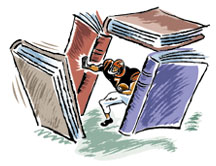 Student-athlete
practice rules eased
Student-athlete
practice rules easedIvy presidents address off-season time and increase academic requirements
By Argelio R. Dumenigo
Illustration by steven veach
The Ivy League presidents have revised a league policy that had established a mandatory seven-week rest period for student-athletes. The new policy gives the students more flexibility in scheduling the downtime.
At its annual meeting June 17, the Council of Ivy Group Presidents also raised the minimum academic requirements for admission to any Ivy League school for recruited athletes, as measured by secondary school rank and standardized test scores. The changes in admission requirements will not affect Princeton, said President Tilghman, since the “academic qualifications of our athletes in total are within the range established by the Ivy presidents.”
In June 2002, the presidents instituted a 49-day moratorium on offseason practice, mandating that the rest days be taken in blocks of at least one week. There were to be “no required athletic activities” and “no coaching supervision of voluntary conditioning or other athletic activities” during this time. Responding to protests and to alternatives proposed by student-athletes, coaches, and some athletic directors, the Ivy presidents reviewed the policy and decided to allow students to determine how to allocate their time off. The consecutive-day requirement will remain intact only preceding off-season examination periods.
Chanel Lattimer ’05, a member of the Princeton track team and the Princeton Varsity Student-Athlete Advisory Committee, said she considers the change a victory. “This decision also evidences that our Ivy League presidents are really listening to their students and their opinions, which I think is vital to a successful university,” Lattimer added.
“This is an excellent outcome and a significant improvement over the plan that was adopted last year,” said President Tilghman. “It reflects extensive conversations this spring with student-athletes, coaches, and others, and it respects the different circumstances of different institutions and different sports. At the same time, it continues to express the league’s commitment to ensuring that athletes have the time to achieve their academic goals and participate broadly in the extracurricular life of the campus.”
Also, for the first time, the presidents set a limit on the number of
athletic recruits that can be enrolled at an Ivy institution during any
four-year period, in all 33 Ivy championship sports. This limit will vary
for each school depending on which sports it offers, but it also is not
expected to affect Princeton, since the University’s total number
of recruited athletes is “well below the new upper limit that has
been established by the league,” Tilghman explained. ![]()
Argelio R. Dumenigo is a former PAW associate editor.

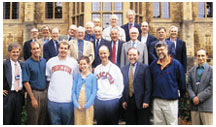 A
scholarly reunion
A
scholarly reunion
Former Rhodes Scholars gathered in Oxford for four days in early July
to celebrate the centennial of the Rhodes Trust. More than 100 Princeton
students have received Rhodes Scholarships, and 23 attended the festivities.
They were: left to right (front) Scott Rafferty ’76, Mike McCaffery
’75, Trevor Leitch ’02, Kate Buzicky ’02, Richard Balfour
’71, Nicholas Ulanov ’78, Mark Janis ’69, and Randy Weinberg
’74; (middle) Tim Gokey ’83, Will Hunter ’77, Morton Kahan
’64, Peter Paine ’57, Sam Holt ’58, Lewis Mudge ’51,
Joe Nye ’58, Paul Sarbanes ’54, Jim Hester ’46, David Mehnert
’87, Bruce Partridge ’62 and John Alexander ’67; (back)
Larry Grisham (Princeton research physicist), Bob Rawson ’66; and
Marc Lackritz ’68. ![]()

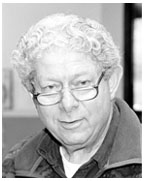 In
memoriam
In
memoriam
Photo: Office of Communications
Aaron Lemonick *54, a physicist, gifted teacher, and longtime University administrator, died June 19. He was 80.
After serving in the Air Force during World War II, he attended the University of Pennsylvania as an undergraduate and earned his doctorate in physics at Princeton in 1954. He joined the Princeton faculty as an associate professor of physics in 1961 after teaching at Haverford College and working at Brookhaven National Laboratory.
In the early 1960s, Lemonick worked on the planning and construction of the Princeton-Penn Accelerator, a particle accelerator that yielded several important discoveries in physics.
He served as dean of the Graduate School from 1969 to 1973 and as dean of the faculty from 1973 to 1989. Under Lemonick’s guidance, several departments, including molecular biology, mathematics, and philosophy, went through important periods of growth or renewal.
Throughout his career, Lemonick was a dedicated teacher, whose bold classroom style and caring mentorship inspired generations of physicists as well as nonscientists.
In 1989, Lemonick returned to teaching full-time. The University honored him with the President’s Award for Distinguished Teaching when he retired in 1994. In 2001, Princeton awarded him an honorary doctor of science degree.
After he retired Lemonick joined the Princeton Teacher Preparation Program’s
Quest initiative, which offers summer science workshops to schoolteachers.
He served as the director of Quest and taught workshops in astronomy and
electricity and magnetism until his death. He had planned to lead a unit
on astronomy this summer. ![]()

Princeton’s newest alumni entered the job market facing an unemployment rate at a nine-year high. Of the 1,090 seniors who responded to a survey conducted by the Office of Career Services (98 percent of the class), 64 percent said they would be working, either full-time, part-time, or in year-long internships. Another 22 percent were planning to attend graduate school, and 9 percent intended to pursue other activities, which included travel, the military, and professional sports.
The 2003 numbers were similar to those from the Class of 2002. But going
back one more year, the difference is noticeable. In the summer of 2001,
only 17 percent of the graduates intended to go to graduate school, and
69 percent planned on working full-time, part-time, or in internships.
![]()

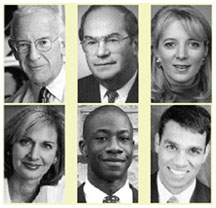 Six alumni
are joining the Board of Trustees. From top left: Peter Lewis ’55,
James McDonnell III ’58, and Louise O’Brien ’82 were named
by the board. Bottom left: Eileen Guggenheim *82, Olivier Kamanda ’03,
and Rajiv Vinnakota ’93 were elected by the general alumni body.
All will serve four-year terms.
Six alumni
are joining the Board of Trustees. From top left: Peter Lewis ’55,
James McDonnell III ’58, and Louise O’Brien ’82 were named
by the board. Bottom left: Eileen Guggenheim *82, Olivier Kamanda ’03,
and Rajiv Vinnakota ’93 were elected by the general alumni body.
All will serve four-year terms.
Lewis, who served as trustee from 1998 to 2002, is chairman of The Progressive Corporation and is a well-known arts and education patron. McDonnell, former vice president of McDonnell Douglas Corporation, supports numerous civic and cultural institutions in St. Louis. O’Brien retired earlier this year as a vice president of Dell Computer and is now a consulting editor with Harvard Business Review.
Guggenheim helped found the New York Academy of Arts, where she was a professor of art history. She also is vice chairwoman of the Prince’s Foundation, begun by the Prince of Wales. Kamanda, the young alumni trustee, majored in operations research and financial engineering, and is a technical project manager for Govolution, an e-commerce government contracting business in Washington, D.C. Vinnakota is president and chairman of the board of the Schools for Educational Evolution and Development Foundation, which established the SEED Public Charter School in Washington, D.C., a public boarding school for middle and high school students.
A. Scott Berg ’71, Brian Johnson ’99, Andrea Jung ’79,
Heidi Miller ’74, Crystal Nix-Hines ’85, and Elizabeth Plater-Zyberk
’72 are leaving the board.
![]()

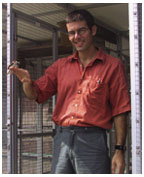 Field
study, aided by technology, reveals surprising information for researchers
Field
study, aided by technology, reveals surprising information for researchers
Photos: Martin Wikelski, with a nonmigrating house sparrow, at the aviary on top of Guyot Hall. (Office of Communications). Hermit thrush (Catharus guttatus) (corbis)
The documentary film Winged Migration this summer sparked a new interest in migrating birds. But birds have long been a focus for Princeton professor of ecology and evolutionary biology Martin Wikelski, whose most recent study on migration was published in the June issue of Nature.
The movie, a visual flapping feast, tracks several species of birds as they make their biannual treks, some as much as 12,000 miles. But what isn’t depicted is what takes place physiologically within the birds.
Wikelski’s study, which followed two kinds of thrushes, Swainson’s (Catharus ustulatus) and hermit (C. guttatus), during a segment of their spring migration from South America to Canada, revealed something unexpected: The small brown songbirds expend more energy on the ground than they do flying.
 “We
were pretty surprised because so far nobody had put together the energy
budget during an entire migration,” says Wikelski. “The costs
at night, when birds are on the ground and when it’s getting pretty
cold, are just about as high as when they fly. They can either migrate
at night or they can heat their body; birds increase their metabolic rate,
which keeps them warm, from the inside. It’s basically like muscle
work, but you can’t see it.” Over the course of the migration
birds can spend twice as much energy on the ground as in the air. This
is partly because the constant starting and landing in foraging flights
are very expensive, says Wikelski, who theorizes that the exertion of
flight keeps the birds warm.
“We
were pretty surprised because so far nobody had put together the energy
budget during an entire migration,” says Wikelski. “The costs
at night, when birds are on the ground and when it’s getting pretty
cold, are just about as high as when they fly. They can either migrate
at night or they can heat their body; birds increase their metabolic rate,
which keeps them warm, from the inside. It’s basically like muscle
work, but you can’t see it.” Over the course of the migration
birds can spend twice as much energy on the ground as in the air. This
is partly because the constant starting and landing in foraging flights
are very expensive, says Wikelski, who theorizes that the exertion of
flight keeps the birds warm.
For the study, Wikelski and his team injected 38 birds with harmless isotopes and attached tiny transmitters that weigh between 0.8 gram and 1 gram. Of the 38, some did not migrate and were kept as controls, and 12 migrated north. In cars, the team followed the birds throughout the night and the next morning recaptured six birds, most about 200 miles away, but one 400 miles away, to determine their energy expenditures in relation to body weight and fat stores.
Wikelski undertook the study, the first to study the migration energetics of songbirds in the field instead of in wind tunnels, with colleagues in Illinois. Now Wikelski and his colleagues are aiming for a much larger tracking study, to progress over the coming decades. They hope to select one species of songbird, capture hundreds of them, attach transmitters, and track them from a space station. “We will look at other things too, including migration patterns, such as whether some birds, such as the bar-tailed godwit, fly directly from Alaska to New Zealand; where common birds, such as the European house martin, winter in Africa; or where the highly endangered aquatic warbler goes in winter. We also want to understand the most important mortality problems for songbirds, i.e., where and why they die.”
Songbirds are only part of Wikelski’s work. “I try to understand why organisms are designed as they are,” he says. Some of the animals he has studied include marine iguanas in the Galapagos and ocelots on Barro Colorado Island, a Panamanian island reserved for scientific research, where transmitters and telemeters track animal travel patterns and biological functions. Wikelski, 37, expects this project to last for decades. “We see it as a pilot system for a lot of others that will be established around the world. We already have people asking us to help them establish their own telemetry systems.”
Wikelski grew up in Bavaria, and became interested in his field when he was 11 and “noticed a large number of cattle egrets in an area near my grand-father’s farm where none of these birds should be — they went astray from Africa to southern Europe.” He sent that information to birdwatchers at an ornithology research institute in Germany, who appreciated the observation and included it in a report. “I couldn’t really believe that anybody was interested in what a kid was doing, so after that I got more and more into that field,” he says.
After earning his doctorate at the University of Bielefeld in Germany,
Wikelski did postdoctoral work at the University of Washington and then
became a faculty member at the University of Illinois at Urbana-Champaign.
He was hired by Princeton in 2000. ![]()
By L.O.

Princeton’s 2002—03 Annual Giving campaign raised almost $34.6 million, with 59 percent of undergraduate alumni participating. The total was about $1.8 million less than the $36.4 million raised in last year’s campaign, which had a participation rate of 58.3 percent.
“This campaign played out against very difficult field conditions,” said Bill Hardt ’63, annual giving director, noting the bad economy and lower stock prices.
Leading the pack was the Class of 1963, which set a 40th-reunion record with just over $5 million. The class has broken a record at every major reunion since its graduation.
Two other major reunion classes set records: The Class of 1983 broke the 20th-reunion mark with $1,910,483, and the Class of 1988 set a 15th-reunion record by raising $1,198,888. Graduate alumni also set a record with $770,288.
The campaign ended with a surge of gifts, including more than 1,000 on the final day, June 30. “With a week to 10 days left in the campaign, neither the $34.6 million nor the 59 percent participation were in the offing,” Hardt said.
Other items of note:
• The 25th-reunion Class of 1978 raised more than $4.3 million.
• The Classes of 1953 and 1958 raised more than $2 million each.
• The Class of 1952, coming off its record-setting 50th-reunion campaign, contributed $431,793 — the highest total among the nonmajor reunion classes.
• The Class of 1948 had the highest participation among major reunion classes with 83.3 percent.
• The Class of 1931 reached 100 percent participation for the second consecutive year.
• The youngest five classes (2002, 2001, 2000, 1999, and 1998) all exceeded 60 percent participation. ¯
For complete results click
here. ![]()


 Centaurs,
satyrs, and sirens
Centaurs,
satyrs, and sirens
The appearance of mythical mixed beings — centaurs, satyrs, sirens
— in Greek art first occurred during the Bronze Age in Minoan and
Mycenaean art, only to disappear for a few centuries. A resurgence began
around 950 B.C.E. and reflected a new era of contact between Greece and
the ancient cultures of Egypt and the Near East. An upcoming exhibit at
the Art Museum, The Centaur’s Smile: The Human Animal in Early Greek
Art, examines the religious, sociological, and psychological significance
of human/animal creatures for the early Greeks. In the exhibit are more
than 100 objects including (top left) a circa 530 B.C.E. statuette of
a centaur, and a 510 B.C.E. black-figure lekythos depicting the centaur
Cheiron, who instructed the young Achilles in the arts of hunting, war,
healing, and music. The show runs from October 11 through January 18.
(Photos: PUAM)
![]()

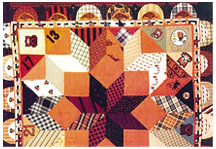 This
year members of the Princetoniana Committee hope to inoculate entering
freshmen with a good dose of Tiger serum. Among the artifacts on view
for them at the committee’s Web site is a quilt made from reunion
jacket material (detail
photo, Princeton University Archives).
This
year members of the Princetoniana Committee hope to inoculate entering
freshmen with a good dose of Tiger serum. Among the artifacts on view
for them at the committee’s Web site is a quilt made from reunion
jacket material (detail
photo, Princeton University Archives).
Since Fred Fox ’39, the University’s first keeper of Princetoniana, died in 1981, efforts to impart Princeton traditions to incoming freshmen have waned. This year, members of the Princetoniana Committee are making a big push to resurrect Tiger indoctrination and pass on the lore.
The committee has a two-pronged plan. A Web page, alumni.princeton.edu /~ptoniana/ciao07.html, has been linked to the Class of 2007 Web site; information about locomotives, songs, pranks, and more is included. And September 10, a special tour of campus will be given for all freshmen. Divided into groups and accompanied by 60 Orange Key guides, the new students will walk the paths where so many have gone before, then meet at Blair Arch for locomotives and the singing of “Old Nassau.”
The University has formed a new institute for international studies. The Princeton Institute for International and Regional Studies replaces both the Council on Regional Studies, an inter-departmental organization of regional study programs, and the Center of International Studies, a research group within the Woodrow Wilson School. Latin American studies scholar Miguel Centeno, professor of sociology, is directing the new institute.
The institute will conduct collaborative interdisciplinary research and teaching on issues of global importance.
 Michael
McKay is Princeton’s new vice president for facilities. McKay, general
manager of plant and services in the facilities department for the past
10 years, has been at Princeton since 1977. He will play a key role in
overseeing all aspects of the University’s physical plant, and in
the planning, design, and construction of capital projects. (Photo of
Michael McKay (office of communications))
Michael
McKay is Princeton’s new vice president for facilities. McKay, general
manager of plant and services in the facilities department for the past
10 years, has been at Princeton since 1977. He will play a key role in
overseeing all aspects of the University’s physical plant, and in
the planning, design, and construction of capital projects. (Photo of
Michael McKay (office of communications))
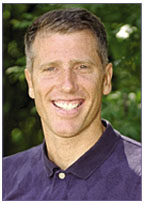 The
Rev. Paul Raushenbush is the new associate dean of religious life and
will focus on building the interfaith community on campus. An ordained
American Baptist minister, Raushenbush has served as youth and young adult
minister at Seattle First Baptist Church, as campus minister for the United
Church of Christ and the Presbyterian churches at Columbia University,
and as associate minister for college and young adults at Riverside Church
in New York City. A graduate of Macalester College, Raushenbush earned
his master of divinity degree with honors from Union Theological Seminary
in New York City. (Paul
Raushenbush photo, Office of Communications)
The
Rev. Paul Raushenbush is the new associate dean of religious life and
will focus on building the interfaith community on campus. An ordained
American Baptist minister, Raushenbush has served as youth and young adult
minister at Seattle First Baptist Church, as campus minister for the United
Church of Christ and the Presbyterian churches at Columbia University,
and as associate minister for college and young adults at Riverside Church
in New York City. A graduate of Macalester College, Raushenbush earned
his master of divinity degree with honors from Union Theological Seminary
in New York City. (Paul
Raushenbush photo, Office of Communications)
William Beaney, who taught political science at Princeton from 1948 to 1967, died July 20 in Denver; he was 84. Beaney was born in Wilkes-Barre, Pennsylvania, the son of a deputy sheriff and a nurse. He worked his way through Harvard, then attended the University of Michigan Law School. World War II interrupted his law studies. He joined the Army as a second lieutenant and was wounded in the Battle of Normandy. After earning his degree, as well as a doctorate, he became a national authority on constitutional law and cowrote a popular casebook, American Constitutional Law, which was widely used.
Princeton Provost Amy Gutmann received a Graduate School of Arts and Sciences Centennial Medal from Harvard, which bestows the honor annually on graduate alumni who have made exceptional contributions to society. Gutmann earned her Ph.D. in government from Harvard in 1976 and joined the Princeton politics department. She has been provost since 2001 and the Laurance S. Rockefeller University Professor of Politics and the University Center for Human Values since 1990.
 |
| The Observatory of Instruction, above, was built in 1877. In the 1960s it was torn down to make way for Robertson Hall. (Princeton Historical Society) |
“Lost Princeton,” on view at the Historical Society on Nassau Street through March, features photographs of lost buildings, many sure to be remembered fondly by longtime Tigers. Included in the exhibit are images of former town favorites Renwick’s, the Balt, Princeton Playhouse, and Toto’s. Also shown are many early University buildings that no longer exist. These include Reunion Hall, the Observatory of Instruction, and the 1875 University Hotel, which was located at the corner of University Place and Nassau Street. The hotel, in operation for eight years, became a dorm in 1884, which was in turn replaced in 1916 by the structure that exists today and forms part of Mathey College.
A newly discovered diary of President Harry Truman confirms a 1951 report
by former New York Times columnist Arthur Krock — denied by the White
House at the time — that Truman had asked Dwight D. Eisenhower to
head the Democratic ticket in 1948. Archivists at Princeton actually authenticated
the claim more than two decades ago. Krock’s collection of memoranda,
correspondence, and other papers that documented his stories’ sources
are housed in Princeton’s Mudd Manuscript Library. Among the papers
is a description of Truman’s request authenticated by Supreme Court
Justice William O. Douglas’s signature. ![]()
